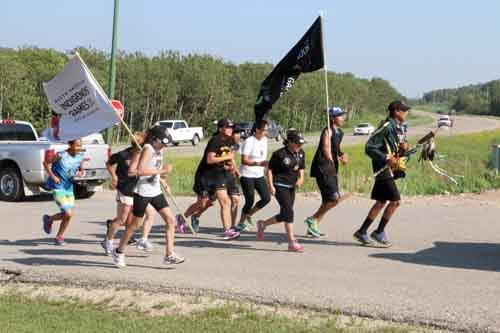Historically the lance run was performed by scouts within First Nation culture as they looked for seasonal camps or to spread important messages through communities. As they searched through new territory they would be met, honoured, and helped through their journey.
With the coming of Europeans, cultural practices of the First Nations became dormant; but, as attitudes towards race changed pride in First Nations culture has developed.
Beginning on Saturday, July 20, the North American Indigenous Games (NAIG) will be held in Regina. Here First Nations from across Canada and the United States will compete in a variety of sporting events to promote pride in culture and the youth of First Nations across North America.
Today the lance run is comparative to the Olympic flame which is carried throughout communities prior to the start of the Olympics. This is where the lance run parallels the Olympic flame in it is taken through communities prior to the NAIG with welcoming ceremonies held at numerous First Nations communities throughout Saskatchewan.
The lance will be run into the Opening Ceremonies by 12 youth who have travelled across Saskatchewan.
On Friday, July 11, lance runners were welcomed in both Pheasant Rump First Nations and White Bear First Nations in celebration of the upcoming games.
Lance runners included Gabrielle Geddes, Justin Smallchild, Kyle Kay, Jarred Asoon, Stephanie Worm, Nathan Blackbird, Shane Blackbird, Ernest Brown, Shayla McNabb, Alexis Isnana, and Jaylynn Allen. Missing from the run was Jesse Star who was away training for the upcoming games.
Marnie Ross, one of the chaperones during the lance run and the coach of the Saskatchewan Track and Field Team, explained that the run began on July 1 in Prince Albert.
"The kids have run over 180 km, since the first of July," Ross stated. "This is our 18th community [Pheasant Rump] and we will be headed to White Bear, which will be our last community before the break."
"The kids have been out for 12 days and will come back on the 18th to run from Fort Qu'Appelle to Regina for the opening ceremonies."
Ross went on to explain that the lance is a spiritual journey for the youth and encompasses the spirit of the Indigenous Games. That in being a part of this they youth have grown and become more confident in themselves.
"Traditionally the lance runners went from community to community spreading important messages and they have put that spirit in it, this spirit of the games" Ross explained. "Symbolic in the lance is that it was specially made to honour and remember the past, but is also a way of spreading the message of healthiness and pride amongst athletes and communities across North America."
The lance runners first arrived in Pheasant Rump just before 1 p.m. after having stopped in Ocean Man First Nations.
At Pheasant Rump the runners were welcomed as they came up the hill with the lance by drummers Steven Eashappie, Jackson Littlechief, Willy Kennedy, and Nakota Kennedy who make up the Red Iron Singers. With a small group gathered the runners lined up and were welcomed by Ira McArthur the Chief Elect of Pheasant Rump. The runners shook hands with all of those gathered and then shared lunch.
The two symbols of the games, a larger buffalo and a smaller buffalo, essentially mascots of the games came out to great people with the young kids running to have their photos taken with them. The Red Iron Singers then performed with the two buffalo symbols dancing traditionally.
Soon the lance runners were on their way, but only after a prayer was said for them, a smudge of tobacco was given, and Elder James McAurthur presented the youth with an eagle feather to help guide them on their journey.
"We would like to thank the runners for their pursuit of excellence in athletics and for representing our people," Chief Elect McArthur stated. "Thank you for taking the time out of your lives to be good role models."
Following the presentation the youth were taken to the Medicine Wheel, an historic and culturally significant site found on Pheasant Rump First Nations.
Later in the day the lance runners were welcomed at White Bear First Nations. Running from the Band Office to the Bear Claw Casino the lance runners were cheered on by community members. As the runners journeyed, Nakoda Hoksina and Philip St. John, drummed for them.
Met by Elder Josh Kakakeway a smudging was held. Joining Kakakeway in welcoming the runners were Chief Brian Standingready, Edward Littlechief (General Manager of the Casino), and councillors Taneyah Okimasis and Seraine Sunkawaste.
"We are proud to welcome you here today and to say a job well done on behalf of First Nations in Canada and the United States," Chief Standingready stated. "We're looking forward to the games where they expect to see 6,000 athletes and 3,500 volunteers."
A short ceremony took place with Hoksina and St. John performing the Honour Song. Gifts were then given to each runner on behalf of the White Bear First Nations before supper was served.
"Thank you for coming to our territory here," Sunkawaste stated. "It's an honour for us to have you here with us today."
Following the event at White Bear, the lance runners were given the week of July12-18 off before continuing from Fort Qu'Appelle to the Opening Ceremonies in Regina on Sunday, July 20.
Shanelle Littlechief and Tia Pinacie: Softball U19, Carlie Standingready U16 Volleyball, Tori Strongeagle U19 volleyball, Talon Desjarlias 19u Baseball, Tommy Cappo u16 fast pitch, Skylar Deschaumbault 16 u wrestling.




